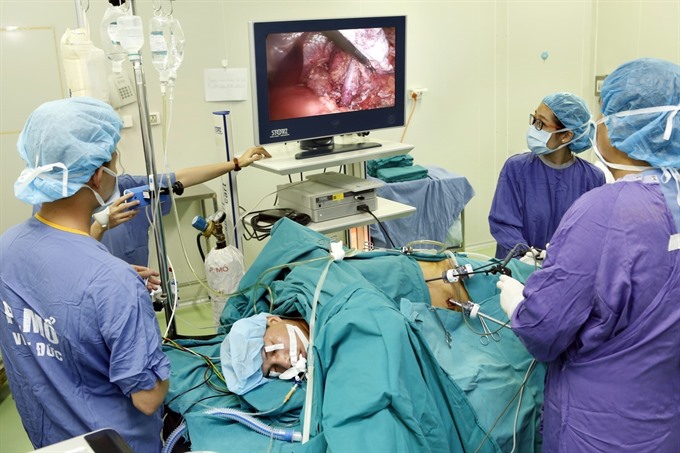 Society
Society

Việt Nam has 19 organ transplant centres, and the biggest problem they face was a shortage of organs to conduct transplants, said professor Trịnh Hồng Sơn, director of the National Coordination Centre for Organ Transplantation.
 |
| An organ transplantation surgery at Việt Nam – Germany Friendship Hospital in Hà Nội. VNA/VNS Photo Dương Ngọc |
HÀ NỘI — Việt Nam has 19 organ transplant centres, and the biggest problem they face was a shortage of organs to conduct transplants, said professor Trịnh Hồng Sơn, director of the National Coordination Centre for Organ Transplantation.
Sơn made the statement at a conference on sharing international experience on organ transplants, which was held on Monday in Hà Nội.
Dozens of patients suffered brain death each day, however, few of them agreed to donate their organs, he said.
The sharing of information between different centres was also insufficient.
Speaking about the problem, Deputy Minister of Health Nguyễn Viết Tiến said that in other developed countries such as the US, the health sector had modern software that helped connect and search for information quickly.
Việt Nam’s health sector should strive to have modern systems so that organ transplant coordination could be quicker and more effective, he said.
Thus experience shared by US experts at the conference could help the national centre to improve.
Doctor David Klassen, chief medical officer of the United Network for Organ Sharing, said that like other countries, organ transplant in the US also faced difficulties related to organ shortage.
But the US was still one of the countries with the fastest progress in the world on organ donation and transplant thanks to awareness of senior leaders leading to a proper legal framework.
In Japan, thanks to effective work of the Japan National Coordination Centre for Organ Transplantation, the country’s organ transplant sector recorded remarkable achievements.
The World Health Organisation considered Japan’s model of organ management and coordination a standard model that other countries should apply, he said.
In France and other European countries, thanks to good work of the French National Coordination Centre for Organ Transplant, all organs from donors were transplanted effectively for patients in France and all of Europe.
In Việt Nam, Nguyễn Hoàng Phúc, deputy director of the National Coordination Centre for Organ Transplantation, said that the Law on Organ Transplantation was issued in 2006, quite late compared with other developed countries, but Việt Nam’s health sector caught up with other countries’ progress in organ transplants.
Nearly 20,000 people registered to donate their organs after death, increasing hundreds of times compared with five years ago.
However, he said, regulations on the issue were still limited. They did not include proper benefits for donors and their families and rules for funds’ participation.
Phúc proposed to amend the regulations towards setting up coordination centres for different areas.
Live donors should be supported with all expenses for consultancy, tests and healthcare after donation. The fund will be from the State budget, he said.
Live donors should be issued with life-long medical insurance cards. The cards should receive priority in any suitable hospitals.
First split liver transplant
For the first time in Việt Nam, doctors at the Việt Nam-Germany Hospital have successfully performed a split liver transplant, dividing a donor’s liver and transplanting it into one adult and one child patient.
The hospital last week announced that organs donated from a 30-year-old brain dead man had been transplanted into five patients, including two kidney and two liver transplant recipients, as well as one heart transplant. In addition, blood vessels had been sent to a preservation bank for other patients.
Doctor Nguyễn Quang Nghĩa, head of the hospital’s Organ Transplantation Centre, said the most complex aspect of the liver transplant was that medical staff had to split the donor’s liver and then transplant it into one child aged eight (was suffering liver failure - hepatic coma due to decompensated cirrhosis, as well as copper metabolism disorder and congenital biliary atresia), and a 49-year-old adult with liver cancer.
A simultaneous dividing and transplantation surgery was performed over 16 hours, witnessing a combination of leading experts from multiple specialties. Six days after the transplants, all five patients have recovered well.
Professor Trần Bình Giang, director of the hospital, said the success of the split liver transplant affirmed the professionalism of local medical staff and offered a new opportunity for patients waiting for liver transplants.
At present, the source of livers for transplant remains limited, mainly from brain dead donors, but with the split liver procedures, one donated liver could help two patients, he said.
The first split liver transplant was carried out in 1988 but it is difficult to implement due to the lack of understanding on the anatomy of the donor liver before dividing, while the transplant for two patients at the same time also required huge technical crews that could perform the liver transplant in emergency conditions with complex techniques.
The first adult liver transplant was successfully performed at the Việt Nam – German Hospital on November 28, 2007. On April 15, 2010, the hospital also successfully carried out the first liver transplant from a brain death donor.— VNS




